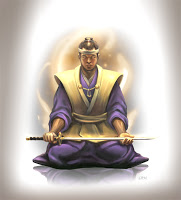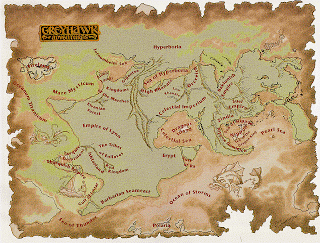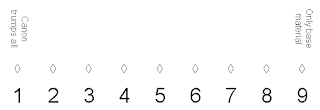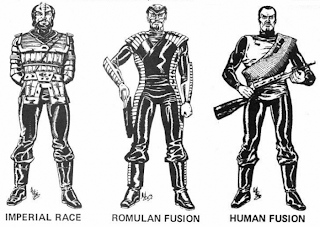When I published the latest of my “Mapping Beyond the Flanaess” maps, a very strange phenomenon occurred. A few people, rather than discussing the maps themselves (aside from an occasional perfunctory “they look nice, but…”) proceeded to rip into them not for their own substance, but because they are based, in large part, on the map that appeared in Dragon Annual #1 back in 1996.
I confess I was somewhat taken aback by this, since it didn’t seem particularly fair to take me to task for something that was done by Skip Williams and Dave Sutherland 16 years ago. But apparently old hatreds simmer for long periods, and will find any excuse to come to the surface. My maps were just a convenient excuse to vent their spleens once more.
It does bring up an interesting question as to how, exactly, we handle issues of canon that we don’t especially like.
While for most people, the question itself sounds almost nonsensical (“who cares about canon?”), it should be remembered that for some fans of specific game settings, the question of whether something is or is not canonical is crucial. After all, stray too far from the published material, and eventually you’re not playing in Greyhawk at all. (The question then becomes, “when does that happen?”)
I was one of the first people (perhaps even the first, but who can remember back that far?) back in the AOL days to use the term “canon” in the context of Greyhawk; I myself had heard it in similar context regarding things relating to Star Trek, and found it an apt term. Discussions as to how canon can be fit together, or made to work, are as much staples of Greyhawk fandom as is the introduction of new material (“fanon”, as the neologism has it). The main fan-based website for Greyhawk is not called Canonfire for nothing.
There are three approaches one can take with canon:
- Everything that is published as canonical material should be used, and trumps anything that fans come up with (even material used in one’s home game). If new canonical material is published which conflicts with homemade material, the latter is discarded in favor of the former.
- Start with a base of canonical material, but with the understanding that canon can be discarded as the game master desires.
- Start with only the very basic material (usually one of the boxed sets or folio, when talking about Greyhawk) and develop your own material from there, ignoring most of the remaining material unless its inclusion is personally compelling. Even the basic material is fair ground for modification.
I should state emphatically that none of these options is right (unless you’re writing for Wizards of the Coast, in which case the first option is your only option), nor is any of them wrong. Most, but not all, game masters and players find themselves following the second option, which is more of a spectrum than a point. One can have a great respect for most canon, and still find onesself willing to discard one or two elements that one really doesn’t like in favor of a homebrewed solution.
That, of course, is what I did with my Castle of the Mad Archmage. I’m not a fan of the Greyhawk Ruins module, and therefore wrote my own megadungeon to replace it. That’s a personal artistic choice, but on the whole I tend to fall into the camp of “use all the canon I can”; probably a 3 on the scale above. There are a few specific items I’ve replaced (my map of the City of Greyhawk, for example), but mostly those have been done because I don’t find the canonical sources as true to their Gygaxian origins as they might have been, and I find my substitutions moreso.
Quite a few people have the same attitude towards the map from DA#1. They don’t like the physical layout, or the choices of which cultures are next to one another, or whatever. That’s fine, and there’s no more wrong with that than their is with my discarding Greyhawk Ruins for my Castle of the Mad Archmage. However, what becomes problematical is how such things are addressed. I feel that complaining loudly and often about what bothers me only goes so far. Without taking matters into one’s own hands and actually doing something to address the concerns, complaining turns into whining.
Accept on the face of it that the canonical source isn’t going to change. Short of your winning the lottery, buying the rights to it, and re-writing things to suit your fancy, chances are that the offending map, or module, or deity, or whatever aren’t going away. In such a case, you have three choices:
- Suck up and deal with it.
- Create your own material to replace the offending material (create a new map or module, etc.).
- Come up with an in-universe explanation for the anomaly and provide a solution that provides a better explanation without breaking canon. Sometimes called “canon reconciliation”. Especially used when two pieces of canon seemingly contradict one another.
That last is something one sees a lot in the Star Trek and Sherlock Holmes fan communities. To take but one example; for years before Enterprise finally gave a canonical explanation, Star Trek fans attempted to explain the discrepancy in appearance of Klingons in ST:TOS and later incarnations. Were there different castes of Klingons? Half-breeds? Mass surgery? Dozens of explanations, some plausible, some tortured, were offered. But the best were the ones that explained the anomaly completely within the bounds of canon.
So, too, can such an attitude be taken towards canonical elements of the World of Greyhawk that one dislikes. To take one example that was brought up by my publication of my maps; the notion that Zindia and Nippon (or as I call it, Woguo) are too close together. In the real world, they are separated by China. Surely if they were closer together, Zindia would have an influence on Woguo, and thus Woguo would have a culture nothing like historical Japan.
To my mind, the solution is not to continually complain that the problem exists, but rather to come up with an interesting and plausible explanation that still falls within the bounds of canon. That’s why in my maps and related material, I posited that there was an extensive Suhfang (the Chinese analogue) population in more direct proximity to Woguo; this population was later conquered and became the Woguo Dominion. Prior to their current expansionist phase, Woguo was deeply isolationist in character. Since the Suhfang lands were much closer to the island of Woguo than the Zindian lands, the vast majority of cultural pollination that took place would come from Suhfang.
 However, it should be remembered that Suhfang in Oerik (at least as I envision it; we know nothing about it but the name and the vaguest outlines of geography) lacks the influence of Zen Buddhism that its real-world counterpart has. It’s still a very deeply polytheistic land, and if Woguo is anything like Japan, we need to account for the much more Zen-like character of its religion.
However, it should be remembered that Suhfang in Oerik (at least as I envision it; we know nothing about it but the name and the vaguest outlines of geography) lacks the influence of Zen Buddhism that its real-world counterpart has. It’s still a very deeply polytheistic land, and if Woguo is anything like Japan, we need to account for the much more Zen-like character of its religion.
I’m sure the answer is as obvious to you as it was to me. The proximity of Zindia now becomes not a problem, but a solution! What little Zindian cultural pollination there has been of Woguo has been in the form of spirituality, rather than other aspects of culture and technology.
I put this out there not to invite a discussion on this specific idea, but rather as an example of how canon reconciliation is a useful and positive tool. I’m sure the explanation I proffer above will be lacking to some people. The answer, then, is to come up with your own canon reconciliation. Try to come up with an answer that stays within the bounds of canon before you throw something out. You might just find that your explanation ends up being more interesting than what you might have invented in its place.
____________________
Also, please take a minute to check out the Adventures Dark and Deep Kickstarter campaign. Help make the ADD rules supplement, suitable for use with all 1E-compatible games, a reality!












I grew up in the punk rock scene. I have NO idea what it means to have passionately dedicated fans take offense over perceived affronts to what they consider the "true way."
And the loudness is the reason I'm not really part of it anymore.
Canon is most useful as resource material that is generally available and can be pointed to in a conversation to say this is what I used and this is where I changed things. It is a kind of campaign Rosseta Stone where DMs can discuss their unique campaigns and still find common ground and a means of translation. This is why most fan-created material is not useful as canon. If it is not generally available then it provides no easy reference, no common ground between DMs.
I would say that material which belongs in a Greyhawk campaign should have a certain style and quality, but that is purely subjective. I find that many stories have a Greyhawk feel such a Leiber's Lankhmar, some Karl Wagner, even Lovecraft and Clark Ashton Smith, while many talented game writers did not such as Sargent whose Greyhawk was too heavily seasoned for my taste, or the City of Greyhawk Boxed set which was a bit sickly sweet. But it is easier to consider and discuss the CoG Boxed set and Sargent's Greyhawk material with another DM and understand exactly what we are saying, because we can easily access the published source material that is designed specifically for Greyhawk regardless of its style or quality.
I think that the primary category for canonicity would have to be all material published by the company that owns the setting whatever the quality, style or consistency of the material.
Canon is almost the antithesis of roleplaying. Settings like Greyhawk (or Ravenloft or Forgotten Realms) are created and sold to be used by the gaming groups that purchase them and make them their own. Once your party of PCs starts adventuring in a campaign setting and the DM's NPCs respond to them in kind, they leave their mark on the setting and deviate from canon.
Canon is great for passive, static activities like a series of novels or a television show where only one or a few writers dictate things, but not so much for active, dynamic things like roleplaying games. So unless you are an RPG collector/reader and not a player, rigid adherence to canon is not even an obtainable goal.
Excellent article Joe. As always, roleplayers are bright, motivated, enthusiastic and pedantic. I find whining over canon annoying when a big-budget Hollywood film is released (we are spoiled these days, and can be scornful on a whim), let alone when one DM shares a labour of love, without charge, with the community.
I personally find it fascinating to see the many varying interpretations of material that my DM colleagues come up with, and find it an interesting topic of polite conversation. I don't see the point in arguing over canon, though. Gary Gygax seems to have been fine with the idea that the setting was somewhat mutable in form, and certainly intended that his readers used it as they saw fit.
My personal choices as to what I take as carved in stone for Greyhawk are much more flexible than they used to be. I used to be self-conscious about being a Carl Sargent fan, and liking the City of Greyhawk boxed set.Then I guess I just got over myself. I am running two weekly games in the setting, both based in and around The Free City. In my 1st edition game, I use your map of the Free City- I love it, I put a fair bit of work into making my own hard copy colour version, and it is the Greyhawk those players have known since the start. For my Classic D&D Castle Greyhawk game, I'm using the boxed set map, largely because I wanted my players to have access to the Greyhawk Player's Guide, and because I have that stuff and like to get some use out of it. I like that map too, for different reasons, and it is a different campaign. I see no problem with that. Two of my players play in both groups, and I explained the difference, and they accepted it too. What is the big deal everyone?
Joseph: I hadn't meant to sound THAT critical of DA#1's map. I'd feel bad, but since it inspired such a poignant post it's okay.
I'm very appreciative of what you've provided out of the love of our game.
Evolving official canon can be a harsh mistress. For someone who was a 'hawker from day 1, it may have been okay at first, then slowly elements crept in that didn't jive with some DMs and players. For someone jumping in today, a new 'hawker may feel they have to take the whole Cyclopedia Greyhawkia to be faithful.
It's like how Garrison Ernst said in Dragon#1, comparing Oerth to Earth:
"Then the changes were but small, but over the intervening centuries the difference has grown so that there is now no resemblance between
Oerth and Earth when the contemporary models are compared."
This is partly why I hesitate to jump into Greyhawk. How much is needed to play a true Greyhawk style game? I know, as much as the players feels it needs.
BTW, I always preferred the Klingon-fusion theory in ST-RPG over the later Trek explanations.
Not to worry, Yggs. If it had just been one person, I wouldn't have taken it the way I did. But when multiple people make the same point in multiple venues, it says there's something lurking there. Hence the post.
I don't take it personally from anyone who made those points. In fact, I appreciate it, as it allowed me to crystallize my own thoughts on canon, which had been floating around as a "I should make a post on that" in my mind for some time, now.
I've been canontonic before, and I forget the fun of making it up as you go. Your post shed some needed light on that for me.
Thanks, Joseph.
The DA map is one of the most highly interpretable areas left involving GH. When it first came out things were pretty much "as is" then they made that Chainmail western Oerik using the map and it didn't fit perfectly with the Annual, then people started reconciling those fine via OJ or other projects, and then here recently at CF someone found that much of the DA map was yanked from a graphic novel named the Black Moon Chronicles by Froideval. Nevermind Gygaxian novel references in the mix. That's alot of differing sources pulling here and there. Fans aren't sure what to do with the place!
So, Joseph, your map version is definitely as valid b/c I feel on the Beyond the Flanaess subject we may never have a concensus.
I find that, if I'm a fan of a particular fictional world, I'm really a fan of some elements but not others.
For example in Barsoom I like the 'dying world' and the canals, but I don't like the Tharks' unmitigated brutality.
So even if I tried to play within a canon, I'd probably distort what other fans saw as the point or spirit of the setting. Much like the D&D world has surface elements of Lord of the Rings, but doesn't 'feel' like it.
To even have this conversation, you have to define the audience and the objective.
If the audience is 'academic' — Flanaessophiles that know their stuff — then the conversation will likely be on sources, areas of disagreement, inconsistencies, and possible reconciliations a la Star Trek. Heated arguments ensue about what is or is not canon. Lengthy disclaimers and definitions are required to refine the topic so that everyone can focus on the author's thesis — why are the India/Japan analogues so close together?
In my view, this is a significant part of the audience you are dealing with by posting canon-related material (like your maps) on the web. They read such posts and compare your information to the Oerik version that suits them, and accept or reject accordingly.
If the audience is a group of players for an actual game, it's just a matter of communicating the current state of the game world and where canon starts and stops.
I have nothing to say about Greyhawk, but something to say about what's perceived to be reasonable in explanations. Japan and India are right next to each other – they're connected by sea routes that have effectively functioned as a superhighway for the whole of coastal and island s, e and se Asia for the past 3000 years, to the extent that island Se Asia, including Bali and the Philippines, has been described as a collection of "Indianized" states. Japan is exceptional (and not even all of Japan if you consider Ryukyu) in selectively rejecting Indian influence. Its rejection need not have anything to do with the proximity of China (which is just as close to a bunch of those other states): instead it's an accident of history: the result of particular conquests and treaties and self-conscious choices.
So wh do some groups of fans object to Japan's adjacency to India? Because it doesn't "feel right"? Alas, fans have different feelings about pretty much everything…
Sorry for the ranty tone. Just… erm… venting…
Joe,
I hope you didn't take my comments about the locations of differing cultures residing side by side as whining or whatnot. It certainly wasn't meant to be. I only meant to raise the issue as a topic of conversation. As I said in not so many words, cultural proximity in a fantasy setting is up for grabs. And Richard's statement about some not liking it because it doesn't feel right is certainly spot on: You can't please everyone with your ideas. I'd add: Screw em' and make it the way you want to. 🙂
I'd postulate that the desire by many to remain "canon" is simply to try and approximate Gary's vision of Oerth, and match it the best they can.
I don't personally use the map in DA1, mainly because I don't like the idea of a pangea. But there is no reason why someone else can't take it and run with it. In my opinion what you've begun with your mapping project is taking a turd and making it into a diamond. Of course, this is all simply my opinion and worth very little outside of my own campaign.
Hm, for RPG play purposes I generally find the best approach is to treat a single source as canonical by default – eg for Greyhawk that might be the 1983 box set – then everything else is inspirational, to be used, altered or rejected as best suits the needs of play.
So eg for my Yggsburgh campaign I treat the CZ: Yggsburgh book itself as canonical by default, while other material such as the Eastmark Gazetteer is inspirational, to be taken from selectively but not adopted wholesale.
Likewise for my 4e Forgotten Realms campaign I treat the 4e FRCS as canonical by default, other sources such as older material, published adventures, and fan material are inspirational and used selectively. Often sources are contradictory or nonsensical and need to be discarded or altered.
I have consistently found that this "core & periphery" approach best meets the needs of actual play. I am very concerned to avoid an over-concern with canon, which I feel tends towards sterile exercise. It may be harmless among Star Trek fans, but for RPGers it risks stifling actual play (Traveller's Imperium the classic example here) – and actual play is the point of RPGs.
There are a couple of points I'd like to raise:
-One issue is that many fans will not have access to all the canon sources, and only find out after the fact that something they invented to fill in gaps was in fact covered by canon they didn't have. This happened to me when I was writing my second Company of the Silver Wolf fanfiction novel. I had come up with a route for the protagonists to go through the Gnarley Forest on their way to the Kron Hills, using only the Darlene Map and the information in the old Gygax/Mentzer ToEE module for reference. I had also created an entirely new gnome city in the Kron Hills called Copper Crossing, too.
I wasn't entirely thrilled to later find Anna Meyer's excellent Greyhawk Maps site and find out that a lot of what I came up with was apparently contradicted by canon.
I don't have access to the issues of Dragon Magazine, and haven't read through all of the 2E Greyhawk modules or sourcebooks, so a lot of what Anna incorporated in her work was something I never knew about. As I'm rewriting and improving the initial fanfic manuscript, I'm using Anna's maps to help me more accurately plot out the protagonists' journey, but I am keeping Copper Crossing as the "capital" of the Kron Hills gnomes rather than Tulvar, because I like the name and concept.
-The other point is that some canon just plain sucks in my view, and I don't care for the changes to the setting. Mr. Bloch's post on the "feels" of different eras of Greyhawk sums up why I can't stand From The Ashes, namely that it took the feel implied by the original 576 CY boxed set and replaced it with the 585 CY one. While the 585 CY one can make for a compelling setting on its own, I don't like how it wrecked so much of what I liked about 576. That's why I don't feel any remorse about ignoring so much of what Carl Sargent wrote and instead just making up my own material where and when I feel like it.
-That said, Mr. Bloch does make a very good point about reconciling seemingly contradictory canon. When the original boxed set described the Flan as making "no appreciable civilizing efforts", while later canon showed that the Flan did indeed have a lot of sophisticated civilizations, I took that as a parallel to the way the real First Nations of North America (Cree, Lakota, Seminoles, etc.) were wrongly considered backwards savages by European colonists. That, in turn, further develops my understanding of the Flanaess as Oerth's equivalent, not of Europe, but of North America.